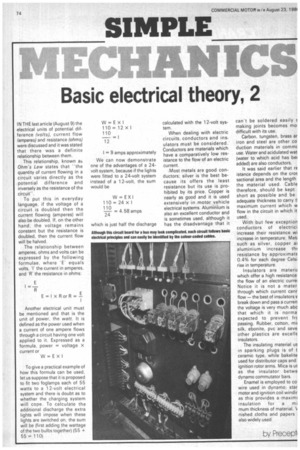Basic electrical theory, 2
Page 76

If you've noticed an error in this article please click here to report it so we can fix it.
IN THE last article (August 9) the electrical units of potential difference (volts), current flow (amperes) and resistance (ohms) were discussed and it was stated that there was a definite relationship between them.
This relationship, known as Ohm's Law states that the quantity of current flowing in a circuit varies directly as the
potential difference and inversely as the resistance of the circuit".
To put this in everyday language, if the voltage of a circuit is doubled then the current flowing (amperes) will also be doubled If, on the other hand, the voltage remains constant but the resistance is doubled, then the current flow will be halved.
The relationship between amperes, ohms and volts can be expressed by the following formulae, where 'E' equals volts, 'I' the current in amperes, and 'R" the resistance in ohms: I -..., E=IxRorR=
Another electrical unit must be mentioned and that is the unit of power, the watt. It is defined as the power used when a current of one ampere flows through a circuit having one volt applied to it. Expressed as a formula, power = voltage X current or VV =EXI To give a practical example of how this formula can be used, let us suppose that it is proposed to fit two foglamps each of 55 watts to a 12-volt electrical system and there is doubt as to whether the charging system will cope. To calculate the additional discharge the extra lights will impose when these lights are switched on, the sum will be (first adding the wattage of the two bulbs together) (55 -455 = 110)
calculated with the 12-volt system.
When dealing with electric circuits, conductors and insulators must be considered. Conductors are materials which have a comparatively low resistance to the flow of an electric current.
• Most metals are good conductors; silver is the best because its offers the least resistance but its use is prohibited by its price. Copper is nearly as good and it is used extensively in motor vehicle electrical systems. Aluminium is also an excellent conductor and is sometimes used, although it has the disadvantage that it can't be soldered easily s. making joints becomes mol difficult with its use.
Carbon, tungsten, brass ar iron and steel are other co duction materials in commc use. Water and acidulated wat (water to which acid has be added) are also conductors.
It was said earlier that re istance depends on the cros sectional area and the length the material used. Cable therefore, should be kept short as possible and be adequate thickness to carry ti maximum current which w flow in the circuit in which it used.
With but few exception conductors of electrici increase their resistance wi increase in temperature. Met such as silver, copper al aluminium increase th( resistance by approximate 0.4% for each degree Celsi rise in temperature.
Insulators are materiE which offer a high resistance the flow of an electric currei Notice it is not a mater through which current canr flow — the best of insulators v break down and pass a curren the voltage is very much aloe that which it is norma expected to prevent frc passing. Rubber, cotton, mu silk, ebonite, pvc and seve other plastics are excelle insulators.
The insulating material us in sparking plugs is of t ceramic type, while bakelite used for distributor caps and ignition rotor arms. Mica is us as the insulator betwe dynamo commutator bars.
Enamel is employed to co' wire used in dynamo, star motor and ignition coil windir as this provides a maxim' insulation for a mi mum thickness of material. V nished cloths and papers also widely .used.
by Precept




















































































































